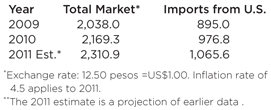GORDON FELLER, International Affairs Consultant
| Mexico’s market size for equipment/services (U.S. $millions) |
 |
At the end of 2011, Mexico, through state oil company Pemex, was the world’s seventh-largest crude oil producer and among the 15 largest natural gas producers. Crude and condensate output last year averaged 2.597 MMbpd, down 1.6% from 2010’s figure. During 2011, 1,132 wells were drilled. The forecast calls for a 1.6% increase to 1,150 wells this year.
Pemex’s major crude oil production and drilling takes place in the Chicontepec, Cantarell and Ku-Maloob- Zaap regions. Regarding natural gas, the major regions are Cantarell, Crudo Ligero Marino, Burgos and Veracruz. Virtually all natural gas activity is onshore.
According to the most recent summary from the end of 2010, Pemex’s E&P infrastructure included: 344 production fields; 6,382 exploration wells; 225 marine platforms; 12 gas processing centers; 9,500 km of gas pipelines.
During January 2012, Pemex said that its production in the Chicontepec area improved to an average 63,313 bopd, including a one-day high of 65,300 bopd. The company said that the increased production resulted from “technological innovation, as well as initiatives aimed at reducing costs and implementing operational best practices that apply to Pemex.”
Pemex’s wholly-owned E&P subsidiary has budgeted an estimated $2.7 billion for specific projects to be executed from 2011 to 2013. There are three primary categories for this spending. The first is for oil drilling in onshore, mature fields. Specifically, this relates to Magallanes, Santuario and Carrizo fields in the state of Tabasco. Drilling also will continue in the Chicontepec and Poza Rica regions of the state of Veracruz.
The second category of spending relates to drilling for oil offshore, including shallow- and deepwater wells. Pemex has conducted studies for exploration in the Gulf of Mexico and has identified nine areas with a potential for crude oil. The areas have water depths ranging from 800 to 1,500 ft. The areas include Perdido, Oreos, Nancan, Jaca-Patini, Lipax, Holok, Temoa, Han and Nox-Hux.
The third category of spending involves drilling and production of non-associated gas onshore. The areas involved are Burgos, Veracruz, Macuspana and San Manuel. It should be noted that the overall Pemex E&P budget for 2012 has been set at $18.36 billion (exchange rate of 13.7165 pesos = US$1.00), which is 84% of the company’s total budget of $21.96 billion.
Meanwhile, in January 2012, Pemex began seeking bids to exploit mature oil fields in northeastern Mexico, which it said could produce 100,000 bopd within three or four years. Up for bids are six areas in northern Veracruz state and southern Tamaulipas state, including two offshore areas. This is the second round of incentive contracts that Pemex has offered under a model that was designed after a limited overhaul of Mexico's oil laws in 2008. The first of the new flexible contracts was awarded to Petrofac and Schlumberger last year for reactivation of mature, onshore fields in southern Mexico. Pemex expects to award contracts for the latest round in June. The company is also working on model contracts for the onshore Chicontepec basin, which should be ready by mid-year.
Equipment/service market. Pemex’s E&P subsidiary is the major end-user of equipment and services. Mexico’s total market for drilling and production equipment and services during 2010 was $2.1 billion. When the tally for 2011 is released, it should have increased to $2.3 billion, (see table). Market growth will continue into 2013. U.S. companies claimed 51% of the imported equipment market in 2010 and 52% at the end of 2011.
The market for oil and gas drilling equipment and services is expected to grow at an average 6.5% from 2011 to 2013, due to priorities set by Pemex to continue drilling projects to find new reserves of crude oil (including in mature fields) and gas to meet domestic and export market demands. According to Pemex, 80% of the demand for drilling equipment will be imported by large contractors for turnkey projects announced in national and international tenders and by invitation-only tenders. 20% of the demand will be supplied by representatives and distributors of drilling equipment with offices in Mexico. Total imports of equipment and services are expected to increase 7% from 2011 to 2013.
In January 2012, Petrofac and Schlumberger announced that they had formed a new alliance to provide production-related services to Pemex. This is not the first cooperative efforts for these firms, as they were awarded contracts in the first round of integrated service contracts. In addition to Mexico, the firms have expressed interest in cooperating together in several other Latin American countries. 
THE AUTHOR
|
|
GORDON FELLER has covered the global oil and gas industry's ups-and-downs for more than 25 years. He completed bachelor’s and master’s degrees in international affairs at Columbia University, graduating cum laude with honors in both cases. Since then, Mr. Feller has focused on many facets of the international oil and gas industry, from the fast-changing dynamics of the market, to industrial nuts-and-bolts, rising consumption in hyper-growth emerging economies, and political risks facing energy investors.
|
| |
| |
| |
| |
|



